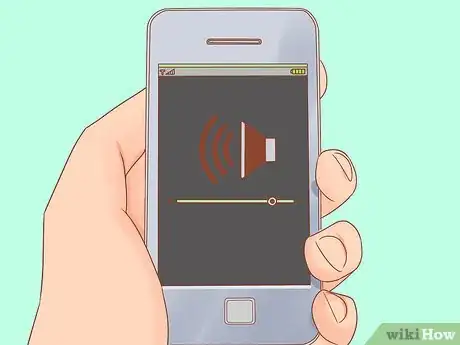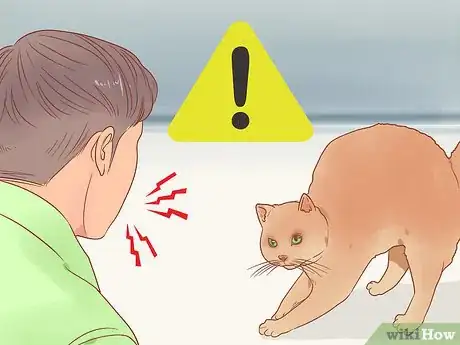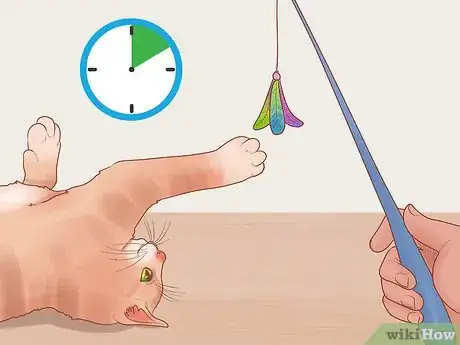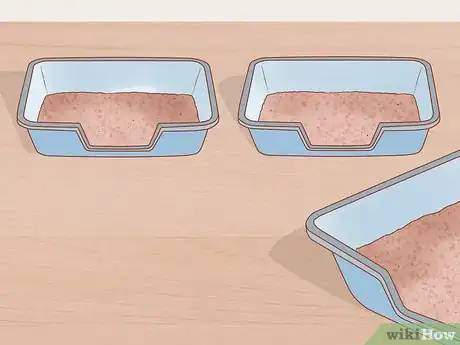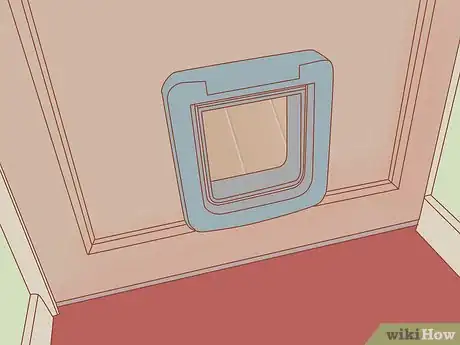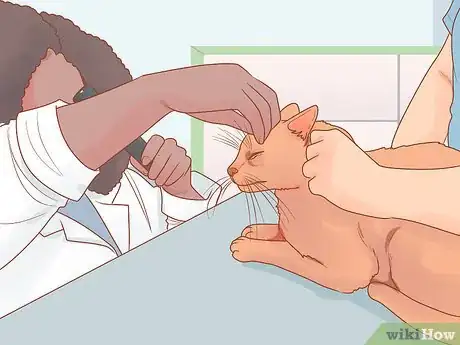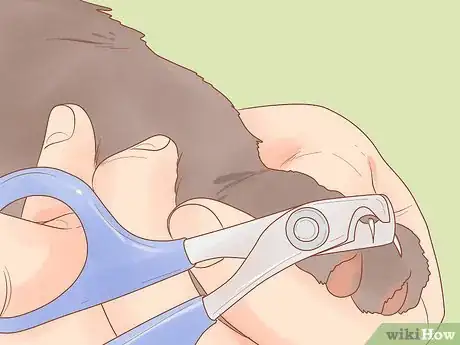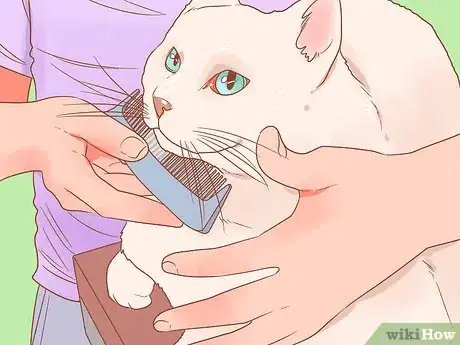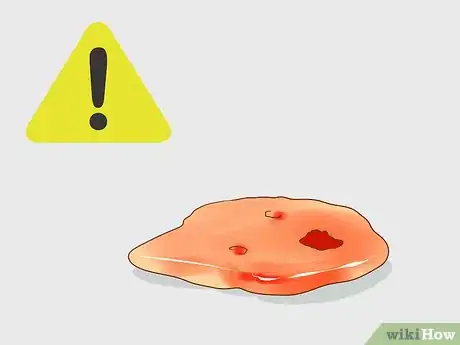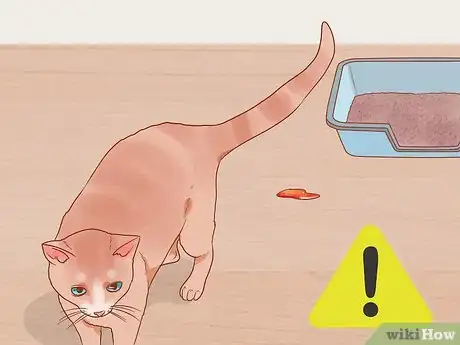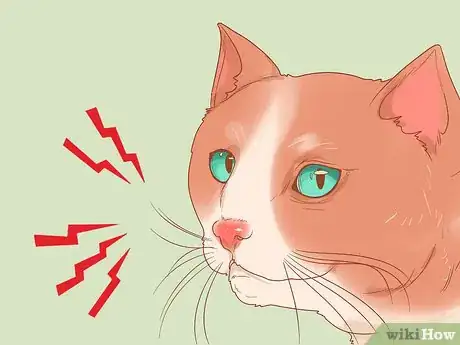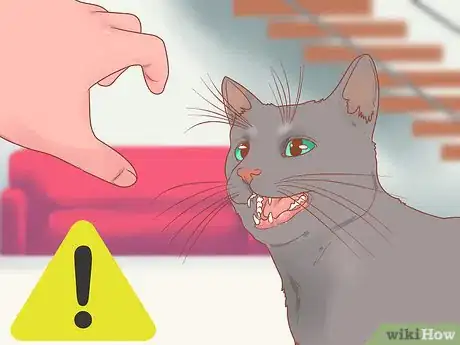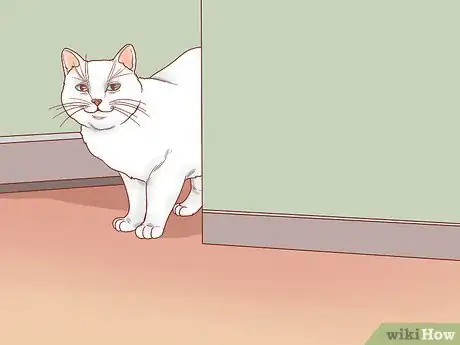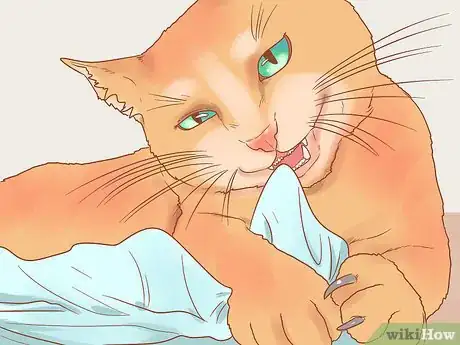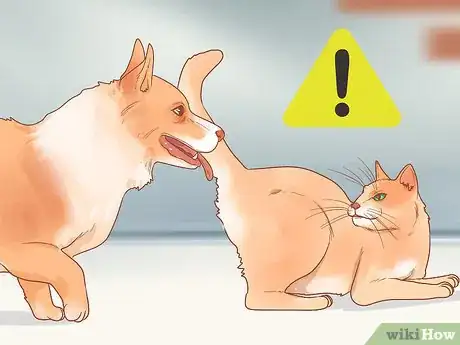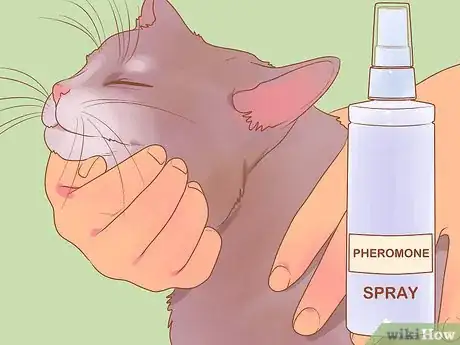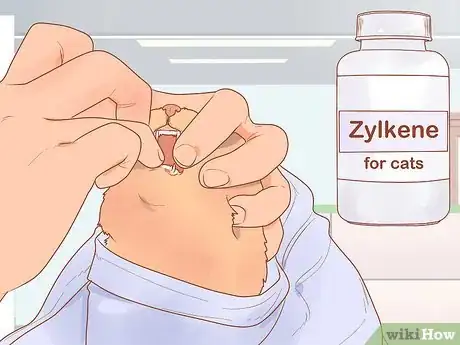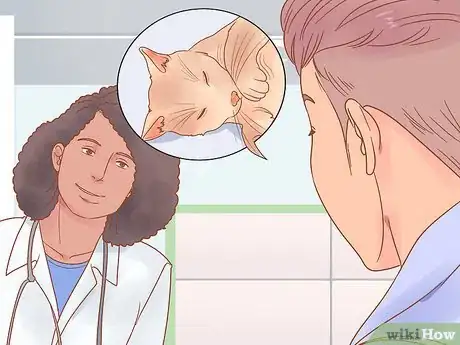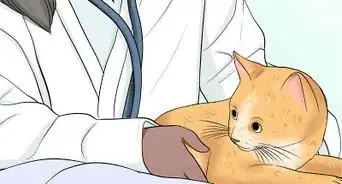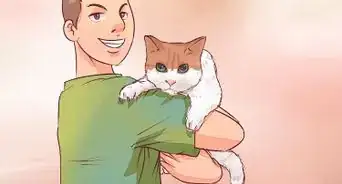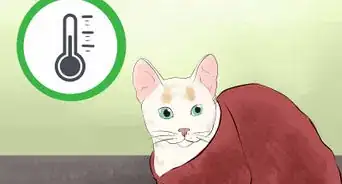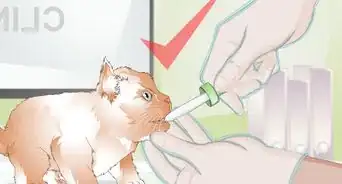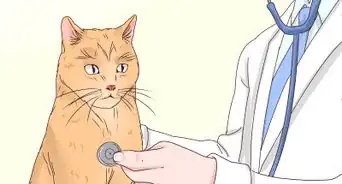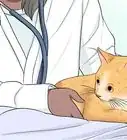This article was co-authored by Brian Bourquin, DVM. Brian Bourquin, better known as “Dr. B” to his clients, is a Veterinarian and the Owner of Boston Veterinary Clinic, a pet health care and veterinary clinic with three locations, South End/Bay Village, the Seaport, and Brookline, Massachusetts. Boston Veterinary Clinic specializes in primary veterinary care, including wellness and preventative care, sick and emergency care, soft-tissue surgery, dentistry. The clinic also provides specialty services in behavior, nutrition, and alternative pain management therapies using acupuncture, and therapeutic laser treatments. Boston Veterinary Clinic is an AAHA (American Animal Hospital Association) accredited hospital and Boston’s first Fear Free Certified Clinic. Brian has over 19 years of veterinary experience and earned his Doctor of Veterinary Medicine from Cornell University.
There are 7 references cited in this article, which can be found at the bottom of the page.
wikiHow marks an article as reader-approved once it receives enough positive feedback. In this case, several readers have written to tell us that this article was helpful to them, earning it our reader-approved status.
This article has been viewed 300,920 times.
If you've noticed changes in your cat's behavior lately, it's possible that she's feeling stressed. What we perceive as stressful and what a cat sees as stressful can be quite different, and it doesn't take much to disturb her peace of mind. Changes to her routine, a stray in the garden, a new brand of cat litter, an owner going on holiday, or a trip to the vet—all these can potentially trigger an upset. Not only is stress unpleasant for her (and you), but it can also cause health problems by reducing immunity, increasing inflammation, and leading to over-grooming. For these reasons, it's easy to see why it is important to reduce stress as much as possible for your cat.[1]
Steps
Reducing Environmental Stress
-
1Turn down loud music. Cats have sensitive ears that can be hurt by loud music, loud television, or other sources of noise.
- Comfort a cat that's frightened by loud noises outside the house, particularly fireworks or thunderstorms. Take her into an interior room or close the curtains, put the TV or radio on low, and make sure the cat has a "bolt hole" where she can hide until the ordeal is over.[2]
-
2Know when to comfort your cat. Some cats who are bonded to their owner will benefit from companionship and reassurance (such as the cat who bolts under the comforter during a thunderstorm: she gets comfort from the owner's scent on the bedsheets). However, a truly terrified cat will be too traumatized to accept comfort and will consider human interference a further threat.
- As a rule of thumb, if the cat backs away from you, growls, hisses, or swishes her tail, leave her alone. In fact, look for a way to make her bolt hole more secure, such as putting a towel over the box she is hiding in so that the front is screened and she can't be seen.[3]
Advertisement -
3Give your cat plenty of safe places in the home. A lack of safe places can also stress a cat. If she feels exposed because there are no high perches where she can safely watch the comings and goings, or no dark cupboards to hide in, this in itself is a stress. All it takes to correct this is the simple provision of a cardboard box in a quiet corner, or a tall tower or scratching post.[4]
-
4Try to maintain a peaceful, stable atmosphere at home. Cats are very sensitive to changes to their environment. While some situations are hard to avoid (like moving apartments), try to provide as calm an atmosphere as you can. Arguing and yelling not only stresses you out, but your cat as well.
- If you're going through transitions at home, be sure to tune in to your cat and take all the measures you can to make it as smooth as possible for her. Always provide a safe place where she can hide.[5]
-
5Don't yell at your cat. Cats can't understand the connection between yelling or hitting and something the cat is doing wrong, so trying to discipline a cat this way only makes the cat anxious and afraid.
- Instead, use positive reinforcement to encourage good behavior in your cat. Every time she does something "good," such as using the scratching post, give her a few treats and praise her verbally. The trick to doing this is that the reward must be immediate: cats have short attention spans, so if the reward comes even a few seconds too late, your cat may not understand what it's for.[6]
Reducing Psychological Stress
-
1Give your cat a sufficient amount of "challenging play." Provide your cat with as many opportunities as possible to burn energy doing cat-like things such as hunting or playing. This is especially important for indoor cats, who may lack the mental stimulation that outdoor prowling provides. Getting the cat moderately tired out also helps to use up her nervous energy and to vent stress hormones in physical activity rather than over-grooming.[7]
- Hide treats or dry food around the house and let her hunt for them.
- Have at least three 10-minutes sessions of one-on-one play with your cat. Dangle something enticing for it to chase or toss toys across the room. Cats love to chase and pounce.
- If you own more than one cat, make sure you play with each cat alone every day in addition to group playtime.
- Leave toys out your cat. Acquire a wide variety of toys, but only put a couple within reach of the cat at one time. Every few days pick up the toys you've made available to the cat and put down a couple of new ones.
-
2Provide other entertainment options. Consider locating a bird feeder outside a window for your cat's entertainment, or get an aquarium so your cat can watch the fish swimming.
-
3Reduce competition in households with multiple cats. If you have more than one cat, they may be vying for food, water, toilet space, and attention. The pressure for resources can leave some cats feeling bullied. To make this less stressful, ensure that each cat has its needs provided for.[8]
- There should be one litter box per cat, plus one spare, to decrease competition for toilet facilities.[9] Be sure to keep the litter boxes clean, removing solid waste daily and regularly cleaning the box out with mild dish soap or a solution of bleach in water (1:30 ratio).
- Place multiple food bowls around the house, so that no one cat can monopolize the food at all times.[10]
-
4Discourage stray visitors. A stray in your garden, or even your home (they can enter by cat door!) can make your cat feel psychologically threatened.
- Discourage visits from a stray by removing any food that might be attracting him.
- If your cat goes outside, consider installing a microchip-activated cat flap so the stray cannot come indoors.
- If the stressed cat can see the stray in the garden, it may help to block the lower part of the window to obscure that view (the cat equivalent of hiding your head in the sand, but it works).[11]
Reducing Physical Stress in Cats
-
1Take your cat to a veterinarian to see if health troubles exist. Many stress symptoms can also be symptoms of physical illness. You need to know if you're dealing with a sick cat or a stressed cat (in some cases the former may cause the latter).[12]
-
2Trim claws that have grown painfully long. Sometimes the cause of physical stress is simple to resolve, such as overgrown claws digging into her pads.[13]
-
3Eradicate a flea infestation. Fleas bite the skin and irritate your cat;[14] what's worse, if ingested they can lead to a tapeworm parasite infection. If your cat is scratching frequently and persistently, perform a simple spot check. Buy a fine-tooth comb and run it through her fur around the base of the neck and tail: if you see small, brown shapes about the size of a pin-head, your cat has fleas. Also look for white or black spots between the teeth of the comb: these are flea eggs and dried blood excreted by the fleas, respectively. If you find fleas, you'll need to get rid of them on your cat, and in your home.
- To eliminate fleas on your cat, consult your veterinarian for recommendations on a flea-control program that's right for her.
- At home, you'll need to take measures that include: rigorous vacuuming of all your cat's favorite places, rugs, and upholstery; washing your cat's bedding weekly; and possibly using a spray, fogger, or powder that is safe (follow product directions carefully and make sure the cat is not in the area if that is specified in the instructions).[15]
Detecting Cat Stress Symptoms
-
1Observe changes in urination. Urinary discomfort is a common result of stress in cats.[16] The stress hormones cause the bladder lining to become inflamed, which results in physical symptoms. Keep track of how often your cat visits the tray. Signs of a problem include more frequent urination, discomfort while urinating, and possible blood in the urine.
- These signs should never be ignored; always get the cat checked by a vet.[17] This is because bladder inflammation can lead to a blockage, which is a serious, and potentially life-threatening, problem if untreated.
-
2Notice if your cat is over-grooming. Stressed cats tend to over-groom, indeed they can wash so much that they lick bald patches in their coat. Favorite spots to over-groom include the tummy, inner thighs, and front legs. The action of licking releases natural morphine-like substances which help to comfort the cat and make her feel more secure.
- Again, get your cat checked by the vet before concluding this is stress-related (allergies and parasites can also cause over-grooming).[18]
-
3Look out for diarrhea. Some cats become so distressed that it upsets their stomachs and they develop diarrhea. Regardless of the causes (stress or an infection), get your cat checked by a veterinarian, because medication may be needed to settle the upset stomach.[19]
-
4Notice if your cat is urinating or defecating outside the litter box. This is a telltale sign that your cat isn't happy.[20] The cat may do this either because she feels too stressed to visit the tray, or in order to spread her scent around the house, which makes her feel more secure.
- However, other problems such as arthritis, bladder infections, or stomach upsets can mimic this, so always get your cat's health checked by the vet.[21]
-
5Decide if your cat is meowing or verbalizing excessively. Some cats become very clingy to their owner and try to attract their attention by talking.[22]
-
6Be aware that restlessness is also a sign of stress. A stressed cat may not be able to settle and may pace restlessly, patrolling her territory on the watch for a perceived threat.[23]
-
7Note if and when your cat withdraws from company. A stressed cat may hide away under a bed or in a dark corner. She is literally hiding, hoping to avoid the attention of what is stressing her.[24]
-
8
-
9Determine the cause of your cat's stress. Try to pinpoint when the symptoms started and why. This can help you take action to reduce the source of stress, whether it is physical, environmental, or psychological. Your vet will also want to know when you first noticed the symptoms.
Helping Your Cat Relearn to Feel Relaxed
-
1Consider using feline pheromones to help your cat feel happy. A nursing queen (female cat) gives off pheromones (chemical messengers) which makes her kittens feel safe and content. A synthetic version of these pheromones has been manufactured and sold as Feliway.
- Use the spray Feliway by spritzing bedding, or entrance and exit points so as to amplify ownership by the resident cat.
- Alternatively, buy a Feliway diffuser. The diffuser plugs into an electrical socket and gives off a low level of the pheromone into the air (it is not detectable by humans!). Ideally, plug the diffuser into an electrical socket in the room your stressed cat spends the most time. The effect builds up gradually, so don't expect immediate results, but after a couple of weeks the cat should feel safer and more reassured. (Each diffuser lasts for approximately four weeks and refills are available.)[27]
-
2Try giving your cat Zylkene. Zylkene is a nutraceutical, which is a food supplement that has a pharmaceutical-like action on the body. Because nutraceuticals are not drugs, they are much safer and rarely have side effects. The active ingredient in Zylkene is derived from milk protein and it acts on the same part of the brain as diazepam. This calms the cat and removes some of her anxiety.
- Zylkene is available without prescription and comes in 75 mg capsules. The dose for a cat is a 75 mg capsule once a day, given with or after food. It can take a couple of days to take effect, but if there is no noticeable difference after seven days, it is unlikely to help your cat.[28]
-
3Talk to your vet about medicine that can help manage stress. If your cat is so stressed that she is becoming ill, then your vet might prescribe a medication to help her over this rough patch. Different pharmaceuticals are available; the most commonly used are diazepam, amitriptyline, and fluoxetine.
- None of these drugs are licensed for use in the cat because the manufacturer has not paid to put them through efficacy trials. However, there are considerable banks of data about their safe use in cats, which your veterinarian will discuss with you if she considers this the best course of treatment.[29] [30]
Expert Q&A
-
QuestionMy cat has been pulling out his fur. Could this be stress related?
 Pippa Elliott, MRCVSDr. Elliott, BVMS, MRCVS is a veterinarian with over 30 years of experience in veterinary surgery and companion animal practice. She graduated from the University of Glasgow in 1987 with a degree in veterinary medicine and surgery. She has worked at the same animal clinic in her hometown for over 20 years.
Pippa Elliott, MRCVSDr. Elliott, BVMS, MRCVS is a veterinarian with over 30 years of experience in veterinary surgery and companion animal practice. She graduated from the University of Glasgow in 1987 with a degree in veterinary medicine and surgery. She has worked at the same animal clinic in her hometown for over 20 years.
Veterinarian Yes, overgrooming is a common sign of stress. In the same way a child sucks their thumb to comfort themselves, so a cat derives comfort from licking. Typically the areas they chose to lick are the belly, thighs, or front legs. However, the cat should have a thorough workup for allergies and parasites before any conclusion is drawn about the cause being purely behavioral.
Yes, overgrooming is a common sign of stress. In the same way a child sucks their thumb to comfort themselves, so a cat derives comfort from licking. Typically the areas they chose to lick are the belly, thighs, or front legs. However, the cat should have a thorough workup for allergies and parasites before any conclusion is drawn about the cause being purely behavioral. -
QuestionI have two Bengal brothers who are not used to being apart. One was injured and spent time at the vet, now his brother is hissing and growling at him. How can I make them happy again?
 Pippa Elliott, MRCVSDr. Elliott, BVMS, MRCVS is a veterinarian with over 30 years of experience in veterinary surgery and companion animal practice. She graduated from the University of Glasgow in 1987 with a degree in veterinary medicine and surgery. She has worked at the same animal clinic in her hometown for over 20 years.
Pippa Elliott, MRCVSDr. Elliott, BVMS, MRCVS is a veterinarian with over 30 years of experience in veterinary surgery and companion animal practice. She graduated from the University of Glasgow in 1987 with a degree in veterinary medicine and surgery. She has worked at the same animal clinic in her hometown for over 20 years.
Veterinarian This is a common problem when one cat in a multi-cat household has spent time at the vets. The 'inpatient' will smell strange to the stay-at-home cat, and have acquired the scent of the vet's on his coat. Cats use smell as well as vision to identify each other, so the inpatient will be sending out confusing messages. The simple solution is to keep the inpatient in a separate room at home for a couple of days, so that he picks up reassuring, familiar smells, and then let the brothers be reunited.
This is a common problem when one cat in a multi-cat household has spent time at the vets. The 'inpatient' will smell strange to the stay-at-home cat, and have acquired the scent of the vet's on his coat. Cats use smell as well as vision to identify each other, so the inpatient will be sending out confusing messages. The simple solution is to keep the inpatient in a separate room at home for a couple of days, so that he picks up reassuring, familiar smells, and then let the brothers be reunited.
Warnings
- The advice in this article is not meant to replace professional advice from a veterinarian. Always talk to your vet if you notice physical and/or behavioral changes in your cat.⧼thumbs_response⧽
References
- ↑ Cat Behaviour Explained. Peter Neville. Publisher: Parragon.
- ↑ Cat Behaviour Explained. Peter Neville. Publisher: Parragon.
- ↑ Cat Behaviour Explained. Peter Neville. Publisher: Parragon.
- ↑ Cat Behaviour Explained. Peter Neville. Publisher: Parragon.
- ↑ Cat Behaviour Explained. Peter Neville. Publisher: Parragon.
- ↑ http://www.humanesociety.org/animals/cats/tips/training_your_cat_positive_reinforcement.html
- ↑ Cat Behaviour Explained. Peter Neville. Publisher: Parragon.
- ↑ Cat Behaviour Explained. Peter Neville. Publisher: Parragon.
- ↑ Cat Behaviour Explained. Peter Neville. Publisher: Parragon.
- ↑ Cat Behaviour Explained. Peter Neville. Publisher: Parragon.
- ↑ Cat Behaviour Explained. Peter Neville. Publisher: Parragon.
- ↑ Cat Behaviour Explained. Peter Neville. Publisher: Parragon.
- ↑ Cat Behaviour Explained. Peter Neville. Publisher: Parragon.
- ↑ Cat Behaviour Explained. Peter Neville. Publisher: Parragon.
- ↑ https://www.aspca.org/pet-care/cat-care/fleas
- ↑ Brian Bourquin, DVM. Cat Behavior Trainer. Expert Interview. 20 December 2019.
- ↑ Feline Behaviour: A Guide for Veterinarians. Bonnie Beaver. Publisher: Saunders. 2nd edition.
- ↑ Feline Behaviour: A Guide for Veterinarians. Bonnie Beaver. Publisher: Saunders. 2nd edition.
- ↑ Feline Behaviour: A Guide for Veterinarians. Bonnie Beaver. Publisher: Saunders. 2nd edition.
- ↑ Brian Bourquin, DVM. Cat Behavior Trainer. Expert Interview. 20 December 2019.
- ↑ Feline Behaviour: A Guide for Veterinarians. Bonnie Beaver. Publisher: Saunders. 2nd edition.
- ↑ Feline Behaviour: A Guide for Veterinarians. Bonnie Beaver. Publisher: Saunders. 2nd edition.
- ↑ Feline Behaviour: A Guide for Veterinarians. Bonnie Beaver. Publisher: Saunders. 2nd edition.
- ↑ Feline Behaviour: A Guide for Veterinarians. Bonnie Beaver. Publisher: Saunders. 2nd edition.
- ↑ Brian Bourquin, DVM. Cat Behavior Trainer. Expert Interview. 20 December 2019.
- ↑ Feline Behaviour: A Guide for Veterinarians. Bonnie Beaver. Publisher: Saunders. 2nd edition.
- ↑ Feline Behaviour: A Guide for Veterinarians. Bonnie Beaver. Publisher: Saunders. 2nd edition.
- ↑ Feline Behaviour: A Guide for Veterinarians. Bonnie Beaver. Publisher: Saunders. 2nd edition.
- ↑ Plumb's Veterinary Drug Handbook. Donald Plumb. PharmaVet
- ↑ Feline Behaviour: A Guide for Veterinarians. Bonnie Beaver. Publisher: Saunders. 2nd edition.
About This Article
To reduce stress in your cat, keep radios, televisions, and voices in your home at a reasonable level, since loud noises can be stressful and harmful to its ears. Additionally, provide calm, safe spaces where your cat can go when it feels stressed, like a scratching post or a cardboard box. You should also give it lots of chances to play and hunt, which helps burn nervous energy. For example, hide treats around the house and let it hunt for them, or toss a toy mouse around so your cat can chase and pounce on it. For more tips from our Veterinary co-author, including how to recognize signs of stress in your cat, read on!
